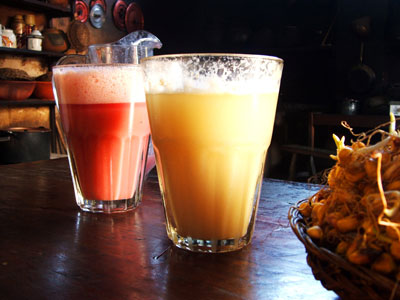
Sample the Many Chichas of Peru
When something is not easily categorized, Peruvians use the common expression ni chicha ni limonada, neither chicha nor lemonade. The saying attests to chicha’s privileged position in the national culture, where it’s served as the banner drink for around 2,000 years.
When something is not easily categorized, Peruvians use the common expression ni chicha ni limonada, neither chicha nor lemonade. The saying attests to chicha’s privileged position in the national culture, where it’s served as the banner drink for around 2,000 years, present at family reunions, religious ceremonies, and holiday celebrations.
The corn-based drink has many variations. Chicha de Jora is a slightly sour corn beer made from the pale Andean Jora corn. It’s fermented in earthenware vats for several days. While some cultures still use saliva to encourage fermentation (this is not common outside of isolated communities and is referred to as Chicha de Muko), the Chicha de Jora that you find in Peru uses chancaca sugar for this purpose. Chicha has been drunk for millennia, and was prominently used in Incan rituals. Production mills have even been found at Machu Picchu, and the skill was taught in Aqlla Wasi centers where women were congregated (whether these were harems, groups of noble women, or feminine schools is not known).
In southern cities such as Cusco and Puno, and in the towns of the Sacred Valley, you’ll find homemade chicha in all of the markets. Bars and homes with a fresh batch of chicha on offer often mark themselves with a bamboo pole topped with a red flower, plastic bag, or flag, and are known as chicherías. Picanterías, the traditional Peruvian eateries, also serve chicha. In fact, if you sample traditional dishes such as Northern Peru’s stewed goat (seco de cabra) and spicy pork stew (adobo) in such eateries, you’ve tasted Chicha de Jora already, as it’s utilized as cooking wine is in other countries.
Regional variations often apply: carob is added for flavor in the north; quinoa, pink peppercorns, or potato starch in the Andes; yucca in the Amazon. When strawberries are added, a tart, pink drink called frutillada is produced. You can also find it in Cuzco and around the Sacred Valley of the Inca as well.
The drink is traditionally served in ceremonial kero cups, but you are just as likely to be served chichi in oversized glasses. It’s traditional to sip the foam and then spill the first drops of the drink on the ground in salute to the Pachamama Earth Mother.
In Lima and the other large cities of the Peruvian coast, you are more likely to come across Chicha Morada, a sweet, unfermented drink made from purple corn and flavored with pineapple rind, quince, cinnamon, cloves, and lime. It’s often served with a garnish of chopped apple. This drink is as different from the fermented versions as can be- it’s basically a homemade soft drink, and is quite easy to drink.
In Peru, "Chicha" has also come to refer to things which are considered cheap, informal, and popular: chicha culture refers to that of newly arrived migrants in Lima, chicha newspapers refers to the yellow press, and chicha music refers to Peruvian cumbia, generally from the Amazonian region.
Fecha de Publicación: 07/10/2014

